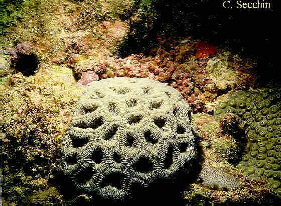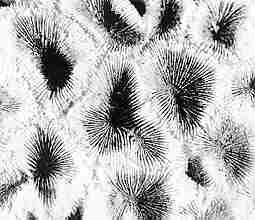

17. Mussismilia hispida
| The Mussismilia hispida colony is hemispheric. Its color varies between light gray, green and blue. It is not very adherent to the substrate, and it has a maximum diameter of about 40 cm. Its calices are larger (around 15 mm in diameter)and more rounded than those of Mussismilia braziliensis. They have more than four cycles of septa and a well developed columella. Laborel (1969a) subdivided this species into two geographic subspecies: Mussismilia hispida ssp tenuisepta |  |
 | which is distributed along the coast of Rio Grande
do Norte, Paraíba, Pernambuco, Alagoas, and
Sergipe states, and has very delicate septa; and
Mussismilia hispida ssp hispida, found on the
coast of Bahia and of Rio de Janeiro states and, in
Ubatuba and São Sebastião, in the state of São
Paulo.
|
| Considering the two subspecies, tenuisepta and hispida, Mussismilia hispida and Madracis decactis have the greatest geographic distribution of Brazilian corals. Mussismilia hispida occurs in reefs from Rocas Atoll to the coast of São Paulo. It is a species endemic to Brazil, presenting affinities with the European species of the Miocene. |
[index] [previous] [home] [next] [taxonomy] [map of occurence]